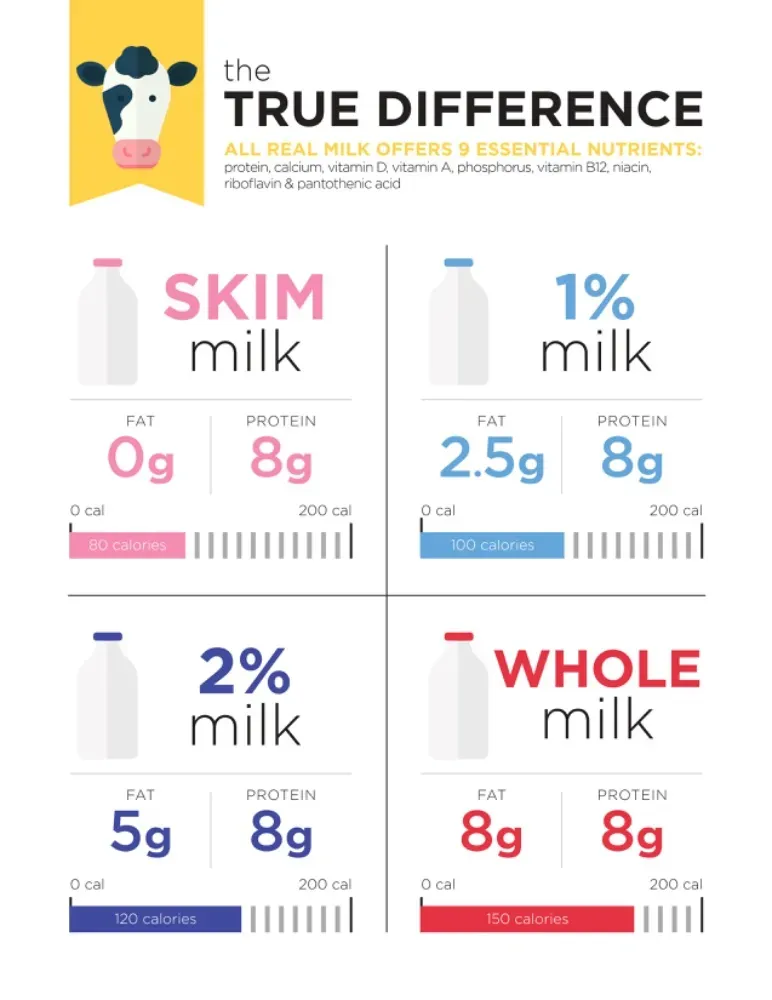Table of Contents
Walking down the dairy aisle these days can feel like navigating a maze. Whole milk, 2%, 1%, skim, fat-free – it's enough to make your head spin. You're probably standing there, staring at the cartons, wondering if you're making the "right" choice, whatever that even means. And let's be honest, the labels don't always clear things up. One common point of confusion? Figuring out, once and for all, is skim milk and low fat milk the same?
Is Skim Milk and Low Fat Milk the Same? Settling the Debate
Is Skim Milk and Low Fat Milk the Same? Settling the Debate
Alright, let's cut to the chase and settle this dairy dilemma. You're wondering, is skim milk and low fat milk the same? The short answer is: it's complicated, but mostly no, not exactly, although "skim" is a *type* of low-fat milk. See? Confusing already. The key difference lies in the *amount* of fat left in the milk after processing. Think of "low-fat" as a broader category, and "skim" as the extreme end of that spectrum, where nearly all the fat has been removed. So while all skim milk is low-fat, not all low-fat milk is skim. It's like saying all squares are rectangles, but not all rectangles are squares. Got it?
Breaking Down the Labels: What "Skim" and "LowFat" Mean
Breaking Down the Labels: What "Skim" and "LowFat" Mean
Skim Milk: The Nearly Fat-Free Option
so let's talk about skim. When a milk carton says "skim," or sometimes "non-fat," it means the milk has been processed to remove as much fat as possible. We're talking less than 0.5% milk fat by weight, often closer to 0.1% or even 0%. The dairy industry uses centrifugal separators – basically, super-fast spinners – to separate the lighter fat from the heavier liquid. It's a pretty efficient process. Think of it as milk on a serious diet. Because so much fat is removed, skim milk tends to be thinner and can sometimes taste a bit watery compared to milk with more fat. Some companies add extra milk solids, like protein or lactose, back in to give it a bit more body and make it taste less like... well, water with calcium.
Remember when everyone was terrified of fat? That's when skim milk really became the poster child for "healthy" milk. It's got all the protein, calcium, and vitamins (often fortified with A and D, which are fat-soluble and removed with the fat) but with minimal calories from fat. It's the go-to for calorie counters or those specifically advised to cut saturated fat intake drastically. My grandma swore by it for her morning coffee, said it kept her "light on her feet." I always thought it just made her coffee look sad, but hey, to each their own.
Low-Fat Milk: A Step Up (or Down?) in Fat Content
Now, "low-fat" is a bit broader, and this is where some of the confusion creeps in when you ask is skim milk and low fat milk the same. In the U.S., "low-fat" milk typically refers to 1% milk. That means it contains 1% milk fat by weight. So, it has more fat than skim milk (which is usually 0% or very close to it), but significantly less than whole milk (around 3.25%) or even reduced-fat milk (2%). Like skim milk, 1% milk goes through the same centrifugal process, but they just don't spin quite as hard or as long, leaving a bit more fat behind. This small amount of fat gives it a slightly creamier texture and a richer flavor compared to skim.
Choosing 1% low-fat milk is often a compromise. You get some of the mouthfeel and flavor that fat provides, without the higher calorie count of 2% or whole milk. It's a middle ground. It still qualifies as "low-fat" according to most dietary guidelines, but it's not the absolute lowest fat option available. It's the milk equivalent of ordering a diet soda but getting regular fries. Not quite full indulgence, but not strictly austere either. It depends on your goals, I suppose.
Nutritional Showdown: Comparing Skim, LowFat, and Other Milks
Nutritional Showdown: Comparing Skim, LowFat, and Other Milks
The Calorie and Fat Scoreboard
So, you've got skim (virtually no fat) and 1% low-fat (a little bit of fat). How does that shake out nutritionally? The big difference, obviously, is the fat content, which directly impacts the calories. Skim milk is the clear winner if you're trying to shave off every possible calorie and gram of fat. A cup of skim milk usually clocks in around 80-90 calories and less than half a gram of fat. Move up to 1% low-fat milk, and you're looking at roughly 100-110 calories and about 2.5 grams of fat per cup. That might not sound like a huge jump, but if you're drinking multiple glasses a day, or using it in cooking, those differences add up. Remember, fat is calorie-dense, so even a small percentage makes a difference in the energy count.
Beyond Just Fat: Protein, Calcium, and Vitamins
Here's where things get interesting and maybe a little less cut-and-dry when asking is skim milk and low fat milk the same nutritionally beyond the fat. Despite the fat removal, skim and low-fat milk pretty much hold their own against higher-fat versions when it comes to the good stuff like protein and calcium. A cup of skim, 1%, 2%, or whole milk all provide around 8 grams of protein, which is solid. Calcium content is also very similar across the board, crucial for bone health. Vitamins A and D are often added back into lower-fat milks because they are naturally found in the fat. So, you're still getting those essential nutrients, just in a package with less fat and fewer calories. The main trade-off is the texture and flavor that fat provides, not a significant loss in core vitamins and minerals (provided they are fortified).
Let's look at the rough numbers per 8-ounce cup:
Milk Type | Calories | Total Fat | Protein | Calcium |
|---|---|---|---|---|
Skim (0%) | ~80-90 | < 0.5g | ~8g | ~300mg |
1% Low-Fat | ~100-110 | ~2.5g | ~8g | ~300mg |
2% Reduced-Fat | ~120-130 | ~5g | ~8g | ~300mg |
Whole (3.25%) | ~150-160 | ~8g | ~8g | ~300mg |
Choosing Your Milk: Which One Fits Your Diet?
Choosing Your Milk: Which One Fits Your Diet?
Who Should Reach for Skim Milk?
so you've seen the numbers. Skim milk is the undisputed heavyweight champion of low-calorie, low-fat dairy. If your primary goal is cutting calories and minimizing fat intake, especially saturated fat, then skim is your go-to. It's the milk equivalent of black coffee – no frills, just the essentials (protein, calcium, vitamins, lactose). Athletes tracking macros might opt for it to get protein without extra fat. People following strict calorie-controlled diets often find it fits their plan better. My neighbor, a marathon runner, practically inhales the stuff, says it's pure fuel without the "junk." It's also a popular choice for cooking and baking when you want the milk solids for texture or binding but don't need the richness fat provides. Think of it as a functional ingredient as much as a beverage.
Why Consider 1% Low-Fat Milk Instead?
Now, maybe you're not counting every single calorie like a hawk, or maybe you just find skim milk tastes like slightly colored water. That's where 1% low-fat milk steps in. It offers a noticeable improvement in texture and flavor over skim because that little bit of fat makes a difference on your palate. It’s still considered low-fat by most health standards, providing a good balance if you're trying to reduce fat from whole milk but don't want to sacrifice taste entirely. It's the happy medium for many families. Does that slight increase in fat and calories derail your entire diet? Probably not, for most people. It really boils down to your personal preference and overall dietary pattern. Are you using that 1% milk to wash down a donut, or pouring it over some plain oatmeal? Context matters, doesn't it?
Here's a simple question to ask yourself:
"Am I choosing this milk primarily for minimal calories and fat, or for a balance of nutrition and palatability?"
Making Your Milk Choice: Wrapping It Up
So, after sifting through the percentages and labels, the core takeaway is clear: when you see "skim milk" and "fat-free milk," you're generally looking at the same product – milk with virtually all the fat removed. This sets them apart significantly from 1%, 2%, or whole milk, which retain progressively higher amounts of fat and, consequently, calories. Deciding which carton to bring home ultimately comes down to your personal dietary needs and preferences. If cutting fat and calories is the priority, skim or fat-free is the straightforward option. If you prefer a richer taste or need the extra fat and calories, one of the higher-fat versions makes more sense. There's no single "best" milk for everyone, just the one that fits your situation.
